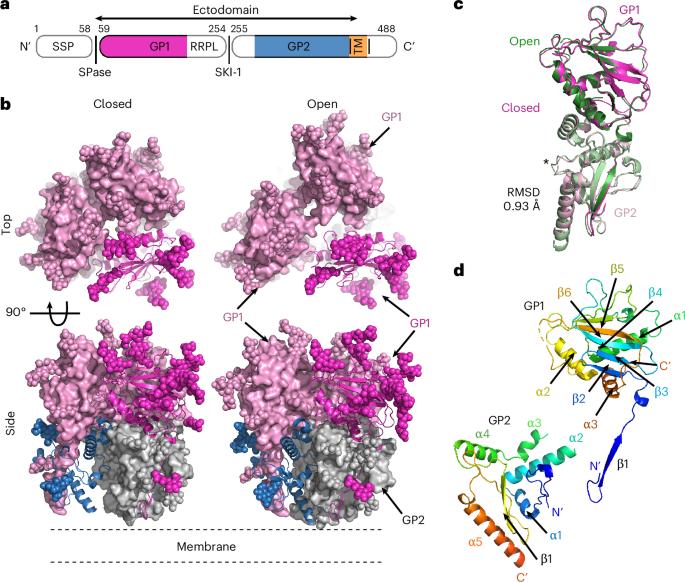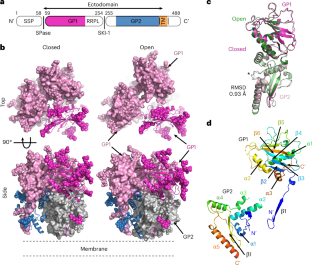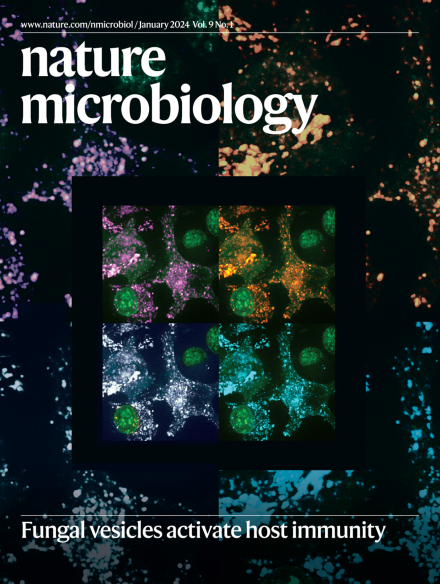Metal-induced conformational changes in the Sabiá virus spike complex
IF 19.4
1区 生物学
Q1 MICROBIOLOGY
引用次数: 0
Abstract
Haemorrhagic fever viruses from the Arenaviridae are a source of concern owing to their potential to cause lethal outbreaks and the lack of effective therapeutics. While structures of spike proteins from ‘Old World’ arenaviruses are available, the differences and similarities to ‘New World’ arenaviruses, such as the Sabiá virus, remain unclear owing to the lack of New World spike structures. Here we present the structure of the isolated spike complex from the Sabiá virus, which mediates viral attachment and entry to the host cells, using single-particle cryo-electron microscopy. We find two distinct conformational states of the spike, representing its native closed state at 2.6 Å resolution and an open state at 2.9 Å resolution that it assumes during cell entry. In addition, we show that the opening of the spike and subsequent cell entry are dependent on acidic pH and an unidentified metal ion. Our study suggests potential differences in the cell entry mechanisms of clade B arenaviruses compared with others in the Arenaviridae family. The Sabiá virus spike complex undergoes conformational changes upon cell entry, from a native closed to an open state, which is dependent on pH and a metal ion.


sabi病毒刺突复合体中金属诱导的构象变化
沙粒病毒科的出血热病毒是一个令人关切的问题,因为它们有可能引起致命的疫情,而且缺乏有效的治疗方法。虽然“旧大陆”沙粒病毒的刺突蛋白结构是可用的,但由于缺乏“新世界”沙粒病毒的刺突结构,与“新世界”沙粒病毒(如sabi病毒)的差异和相似之处仍不清楚。在这里,我们展示了从sabi病毒分离的刺突复合体的结构,它介导病毒附着和进入宿主细胞,使用单粒子冷冻电子显微镜。我们发现尖峰的两种不同的构象状态,代表其在2.6 Å分辨率的天然封闭状态和2.9 Å分辨率的开放状态,这是它在细胞进入过程中假设的。此外,我们还表明,刺突的打开和随后的细胞进入取决于酸性pH值和未知的金属离子。我们的研究表明,与其他沙粒病毒科病毒相比,B支沙粒病毒的细胞进入机制可能存在差异。
本文章由计算机程序翻译,如有差异,请以英文原文为准。
求助全文
约1分钟内获得全文
求助全文
来源期刊

Nature Microbiology
Immunology and Microbiology-Microbiology
CiteScore
44.40
自引率
1.10%
发文量
226
期刊介绍:
Nature Microbiology aims to cover a comprehensive range of topics related to microorganisms. This includes:
Evolution: The journal is interested in exploring the evolutionary aspects of microorganisms. This may include research on their genetic diversity, adaptation, and speciation over time.
Physiology and cell biology: Nature Microbiology seeks to understand the functions and characteristics of microorganisms at the cellular and physiological levels. This may involve studying their metabolism, growth patterns, and cellular processes.
Interactions: The journal focuses on the interactions microorganisms have with each other, as well as their interactions with hosts or the environment. This encompasses investigations into microbial communities, symbiotic relationships, and microbial responses to different environments.
Societal significance: Nature Microbiology recognizes the societal impact of microorganisms and welcomes studies that explore their practical applications. This may include research on microbial diseases, biotechnology, or environmental remediation.
In summary, Nature Microbiology is interested in research related to the evolution, physiology and cell biology of microorganisms, their interactions, and their societal relevance.
 求助内容:
求助内容: 应助结果提醒方式:
应助结果提醒方式:


